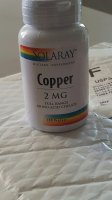I should take silver seriously as well, and consider it together with copperThanks. It seems that with increasing antibiotic resistance around the world modern medicine is quickly re-"discovering" ancient remedies which up until very recently were dismissed as "folk medicine".
Does eating goat meat confer on the benefit of eating copper as in eating shrimps?This reminded me I need to get some more copper for my goats...
Goats need a lot of copper, so much that if you house sheep with them and the sheep use the goat minerals they can get copper toxicity. When goats become deficient in copper their hair loses its colour.
Based off this post, I am wondering if copper is somehow integral to their immune system.


